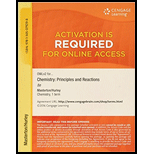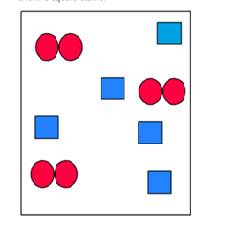
CHEMISTRY:PRIN.+REACTIONS-OWLV2 ACCESS
8th Edition
ISBN: 9781305079298
Author: Masterton
Publisher: Cengage Learning
expand_more
expand_more
format_list_bulleted
Concept explainers
Textbook Question
Chapter 2, Problem 80QAP
Use the law of conservation of mass to determine which numbered box(es) represent(s) the product mixture after the substances in the unnumbered box undergo a reaction.

Expert Solution & Answer
Want to see the full answer?
Check out a sample textbook solution
Students have asked these similar questions
When talking about the acidity of carboxylic acids, is it the same thing to say higher or stronger acidity?
Using the following two half-reactions, determine the pH range in which $NO_2^-\ (aq)$ cannot be found as the predominant chemical species in water.* $NO_3^-(aq)+10H^+(aq)+8e^-\rightarrow NH_4^+(aq)+3H_2O(l),\ pE^{\circ}=14.88$* $NO_2^-(aq)+8H^+(aq)+6e^-\rightarrow NH_4^+(aq)+2H_2O(l),\ pE^{\circ}=15.08$
Indicate characteristics of oxodec acid.
Chapter 2 Solutions
CHEMISTRY:PRIN.+REACTIONS-OWLV2 ACCESS
Ch. 2 - Atomic Theory and Laws State in your own words the...Ch. 2 - State in your own words the law of constant...Ch. 2 - Two basic laws of chemistry are the law of...Ch. 2 - Two basic laws of chemistry are the law of...Ch. 2 - Who discovered the electron? Describe the...Ch. 2 - Who discovered the nucleus? Describe the...Ch. 2 - Selenium is widely sold as a dietary supplement....Ch. 2 - Radon is a radioactive gas that can cause lung...Ch. 2 - How do the isotopes of argon, Ar-36, Ar-38, and...Ch. 2 - Consider two isotopes Fe-54 and Fe-56. (a) Write...
Ch. 2 - Uranium-235 is the isotope of uranium commonly...Ch. 2 - An isotope of americium (Am) with 146 neutrons is...Ch. 2 - Prob. 13QAPCh. 2 - Prob. 14QAPCh. 2 - Prob. 15QAPCh. 2 - See the definition for isobars in Question 15....Ch. 2 - Calculate the mass ratio of a bromine atom to an...Ch. 2 - Arrange the following in the order of increasing...Ch. 2 - Cerium is the most abundant rare earth metal. Pure...Ch. 2 - Consider the three stable isotopes of oxygen with...Ch. 2 - Bromine has two occuring isotopes: 79Br with...Ch. 2 - Rubidium has two naturally occurring isotopes:...Ch. 2 - Strontium has four isotopes with the following...Ch. 2 - Neon is an inert gas with three stable isotopes....Ch. 2 - Naturally occurring silver (Ag) consists of two...Ch. 2 - Copper has two naturally occurring isotopes. Cu-63...Ch. 2 - Silicon (averageatomicmass=28.0855amu) has three...Ch. 2 - Magnesium (averageatomicmass=24.305amu) consists...Ch. 2 - Zinc has four stable isotopes: Zn-64, Zn-66,...Ch. 2 - Chlorine has two isotopes, Cl-35 and Cl-37. Their...Ch. 2 - Lead is a heavy metal that remains in the...Ch. 2 - Silversmiths are warned to limit their exposure to...Ch. 2 - Determine (a) the number of atoms in 0.185 g of...Ch. 2 - For bismuth (Bi), determine (a) the number of...Ch. 2 - The isotope Si-28 has a mass of 27.977 amu. For...Ch. 2 - Myocardial perfusion imaging (MPI) is the latest...Ch. 2 - A cube of sodium has length 1.25 in. How many...Ch. 2 - A cylindrical piece of pure copper (d=8.92g/cm2)...Ch. 2 - Give the symbols for (a) potassium (b) cadmium (c)...Ch. 2 - Prob. 40QAPCh. 2 - Prob. 41QAPCh. 2 - Prob. 42QAPCh. 2 - How many metals are in the following groups? (a)...Ch. 2 - How many nonmetals are in the following periods?...Ch. 2 - Which group in the periodic table (a) has one...Ch. 2 - Which period of the periodic table (a) has no...Ch. 2 - Prob. 47QAPCh. 2 - Prob. 48QAPCh. 2 - Prob. 49QAPCh. 2 - Prob. 50QAPCh. 2 - Prob. 51QAPCh. 2 - Complete the table given below.Ch. 2 - Classify the following compounds as electrolytes...Ch. 2 - Prob. 54QAPCh. 2 - Prob. 55QAPCh. 2 - Prob. 56QAPCh. 2 - Prob. 57QAPCh. 2 - Write the names of the following molecules. (a)...Ch. 2 - Prob. 59QAPCh. 2 - Prob. 60QAPCh. 2 - Prob. 61QAPCh. 2 - Prob. 62QAPCh. 2 - Prob. 63QAPCh. 2 - Prob. 64QAPCh. 2 - Write the names of the following ionic compounds....Ch. 2 - Prob. 66QAPCh. 2 - Complete the following table.Ch. 2 - Complete the following table.Ch. 2 - Prob. 69QAPCh. 2 - Prob. 70QAPCh. 2 - Prob. 71QAPCh. 2 - Prob. 72QAPCh. 2 - Criticize each of the following statements: (a)...Ch. 2 - Which of the following statements is/are always...Ch. 2 - Some brands of salami contain 0.090% sodium...Ch. 2 - Carbon tetrachloride, CCl4, was a popular...Ch. 2 - Prob. 77QAPCh. 2 - Prob. 78QAPCh. 2 - Prob. 79QAPCh. 2 - Use the law of conservation of mass to determine...Ch. 2 - Prob. 81QAPCh. 2 - Prob. 82QAPCh. 2 - Scientists are trying to synthesize elements with...Ch. 2 - Write the nuclear symbol for the element whose...Ch. 2 - Prob. 85QAPCh. 2 - Write the atomic symbol for the element whose ion...Ch. 2 - Prob. 87QAPCh. 2 - Three compounds containing only carbon and...Ch. 2 - Ethane and ethylene are two gases containing only...Ch. 2 - Calculate the average density of a single Al-27...Ch. 2 - Prob. 91QAPCh. 2 - Each time you inhale, you take in about 500 mL...Ch. 2 - Hydrogen gas is prepared in a lab experiment. In...
Knowledge Booster
Learn more about
Need a deep-dive on the concept behind this application? Look no further. Learn more about this topic, chemistry and related others by exploring similar questions and additional content below.Similar questions
- What is the final product when hexanedioic acid reacts with 1º PCl5 and 2º NH3.arrow_forwardWhat is the final product when D-galactose reacts with hydroxylamine?arrow_forwardIndicate the formula of the product obtained by reacting methyl 5-chloro-5-oxopentanoate with 1 mole of 4-penten-1-ylmagnesium bromide.arrow_forward
- The temperature on a sample of pure X held at 1.25 atm and -54. °C is increased until the sample boils. The temperature is then held constant and the pressure is decreased by 0.42 atm. On the phase diagram below draw a path that shows this set of changes. pressure (atm) 2 0 0 200 400 temperature (K) Xarrow_forwardQUESTION: Answer Question 5: 'Calculating standard error of regression' STEP 1 by filling in all the empty green boxes *The values are all provided in the photo attached*arrow_forwardpressure (atm) 3 The pressure on a sample of pure X held at 47. °C and 0.88 atm is increased until the sample condenses. The pressure is then held constant and the temperature is decreased by 82. °C. On the phase diagram below draw a path that shows this set of changes. 0 0 200 temperature (K) 400 аarrow_forward
arrow_back_ios
SEE MORE QUESTIONS
arrow_forward_ios
Recommended textbooks for you
 Chemistry: Principles and ReactionsChemistryISBN:9781305079373Author:William L. Masterton, Cecile N. HurleyPublisher:Cengage Learning
Chemistry: Principles and ReactionsChemistryISBN:9781305079373Author:William L. Masterton, Cecile N. HurleyPublisher:Cengage Learning Chemistry: The Molecular ScienceChemistryISBN:9781285199047Author:John W. Moore, Conrad L. StanitskiPublisher:Cengage Learning
Chemistry: The Molecular ScienceChemistryISBN:9781285199047Author:John W. Moore, Conrad L. StanitskiPublisher:Cengage Learning World of Chemistry, 3rd editionChemistryISBN:9781133109655Author:Steven S. Zumdahl, Susan L. Zumdahl, Donald J. DeCostePublisher:Brooks / Cole / Cengage Learning
World of Chemistry, 3rd editionChemistryISBN:9781133109655Author:Steven S. Zumdahl, Susan L. Zumdahl, Donald J. DeCostePublisher:Brooks / Cole / Cengage Learning General, Organic, and Biological ChemistryChemistryISBN:9781285853918Author:H. Stephen StokerPublisher:Cengage Learning
General, Organic, and Biological ChemistryChemistryISBN:9781285853918Author:H. Stephen StokerPublisher:Cengage Learning Chemistry: Principles and PracticeChemistryISBN:9780534420123Author:Daniel L. Reger, Scott R. Goode, David W. Ball, Edward MercerPublisher:Cengage LearningChemistry: Matter and ChangeChemistryISBN:9780078746376Author:Dinah Zike, Laurel Dingrando, Nicholas Hainen, Cheryl WistromPublisher:Glencoe/McGraw-Hill School Pub Co
Chemistry: Principles and PracticeChemistryISBN:9780534420123Author:Daniel L. Reger, Scott R. Goode, David W. Ball, Edward MercerPublisher:Cengage LearningChemistry: Matter and ChangeChemistryISBN:9780078746376Author:Dinah Zike, Laurel Dingrando, Nicholas Hainen, Cheryl WistromPublisher:Glencoe/McGraw-Hill School Pub Co

Chemistry: Principles and Reactions
Chemistry
ISBN:9781305079373
Author:William L. Masterton, Cecile N. Hurley
Publisher:Cengage Learning

Chemistry: The Molecular Science
Chemistry
ISBN:9781285199047
Author:John W. Moore, Conrad L. Stanitski
Publisher:Cengage Learning

World of Chemistry, 3rd edition
Chemistry
ISBN:9781133109655
Author:Steven S. Zumdahl, Susan L. Zumdahl, Donald J. DeCoste
Publisher:Brooks / Cole / Cengage Learning

General, Organic, and Biological Chemistry
Chemistry
ISBN:9781285853918
Author:H. Stephen Stoker
Publisher:Cengage Learning

Chemistry: Principles and Practice
Chemistry
ISBN:9780534420123
Author:Daniel L. Reger, Scott R. Goode, David W. Ball, Edward Mercer
Publisher:Cengage Learning

Chemistry: Matter and Change
Chemistry
ISBN:9780078746376
Author:Dinah Zike, Laurel Dingrando, Nicholas Hainen, Cheryl Wistrom
Publisher:Glencoe/McGraw-Hill School Pub Co
Types of Matter: Elements, Compounds and Mixtures; Author: Professor Dave Explains;https://www.youtube.com/watch?v=dggHWvFJ8Xs;License: Standard YouTube License, CC-BY